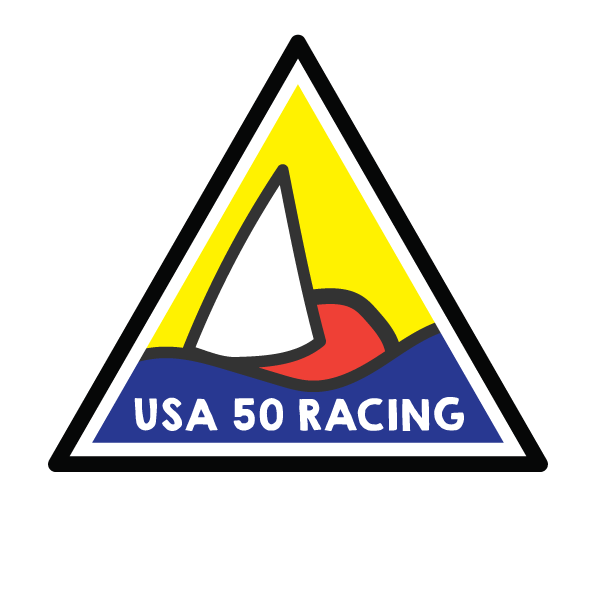The new Nacra 17 class is the fastest race in Olympic sailing. It’s also the only one requiring a man and a woman crew.
Aug 15 2015, 10:20am
Courtesy of US Sailing Team Sperry. Photo by Will Ricketson
Catamarans will make their first Olympic appearance since 2008 at the Rio Games next summer, in a new sailing event featuring the Nacra 17. The boats are light and capsize easily, with curved, keel-like daggerboards that provide enough lift to raise one of the carbon-fiber hulls out of the water while reaching speeds as high as 35 miles per hour. The Nacra 17 boats are the fastest in the U.S. Olympic fleet; only windsurfers can reach higher speeds, and then only under certain conditions.
The Nacra 17 class is also notable for who makes up its two-person crews: with one man and one woman per team, it's one of the few Olympic events where athletes of both genders compete together. The previous Olympic catamaran was the Tornado class. In 2008, the Tornado class was open to both men and women, but the Tornado was a larger, heavier boat and the crews wound up being mostly men. Part of the reason the International Sailing Federation recommended the Nacra 17 for the 2016 Olympic Games was the boat's suitability for both men and women to crew and drive.
Sarah Newberry and Matthew Whitehead will crew the U.S. Nacra 17 this weekend in Rio at the Aquece Rio International Sailing Regatta, when Olympic sailing teams from 52 different countries will test the venue before next summer's Games.
Newberry, 27, is the driver, and Whitehead, 22, the crew. While most teams have been sailing together for the past quadrennium, or four-year Olympic period, they've been sailing together only since December last year. The biggest challenge for Newberry and Whitehead coming into this weekend's test was establishing a level of teamwork required to hang with the 20 fastest Nacra teams in the world.
"We've spent the past six months in a full-on push to get where we need to be," Newberry said. "And we're there. Our communication as a team is really good and really simple. We use concise keywords because if you end up doing double-takes it could be the difference between being upright and not."
"One of the things about the boat that makes it right for being coed is that catamarans have always been a counter-culture corner of the sport of sailing," said Richard Finney, a sailing instructor who coached Newberry on catamarans as a young adult. "I think when they brought the catamaran back they said, 'Here's a chance to do something a little bit different.'"
Newberry and Whitehead racing the Nacra 17
The first English account of catamaran sailing comes from a British adventurer who spotted the boats along the southwestern coast of India in the 1690s. The word "catamaran" is a bastardization of the indigenous Tamil word for the boat, kaṭṭumara. Unlike most sailboats, catamarans grew from beach culture. They were designed to be launched from beaches, and the people who crewed them reflected their heritage.
Catamarans have long had a sort of outsider status. In a 1876 New York Yacht Club race, for example, a Long Island teenager in a catamaran beat out a roster of New York City millionaires; multi-hull boats were banned from the club's races for the next hundred years. In the 1960s, Hobart Alter, a sailor, surfer, and fiberglass-and-board pioneer who died last year, developed the Hobie Cat, probably the most widely known catamaran—yet another non-traditional sport that emerged from Southern California.
"Catamarans don't fit into yacht club parking lots, or boat parks," Finney said. "They take up more space, and they're wider. They've always been problematic. The boats are different, and the people who crew them are different."
ADVERTISEMENT
To guarantee their places on the U.S. Olympic squad, Newberry and Whitehead will compete in two qualifying events next winter: the ISAF World Sailing Cup in Miami and the Nacra 17 World Championships in Clearwater, Florida.
"The two events are quite close together, they're both in the U.S., and the combined results from those two events are the Olympic trials in that class," said Josh Adams, managing Director of US Olympic Sailing. "Sarah and Matt are focusing on both types of qualifying: to make sure the U.S. has a spot at the Games in the Nacra 17 class, and to make sure they're the crew."
While Newberry and Whitehead will measure their teamwork against the other international teams this weekend in Rio, the regatta serves more as proof of readiness for the venue than for the athletes themselves.
"Some of it's still under construction, but everything seems to be on track and doing well," Adams said. "So far, no major problems."
One of the lingering questions concerning all saltwater sports at the 2016 Games, however, has been water quality in Guanabara Bay. Newberry said it's something people are thinking about.
"There's a lot of conversation about that right now, but we just have to go out and do our jobs," she said. "The U.S. Sailing Team came down and tested the water quality and tells us it's fine. That makes going out there easy because what else can we do? We feel we've taken all of the precautions we can."

